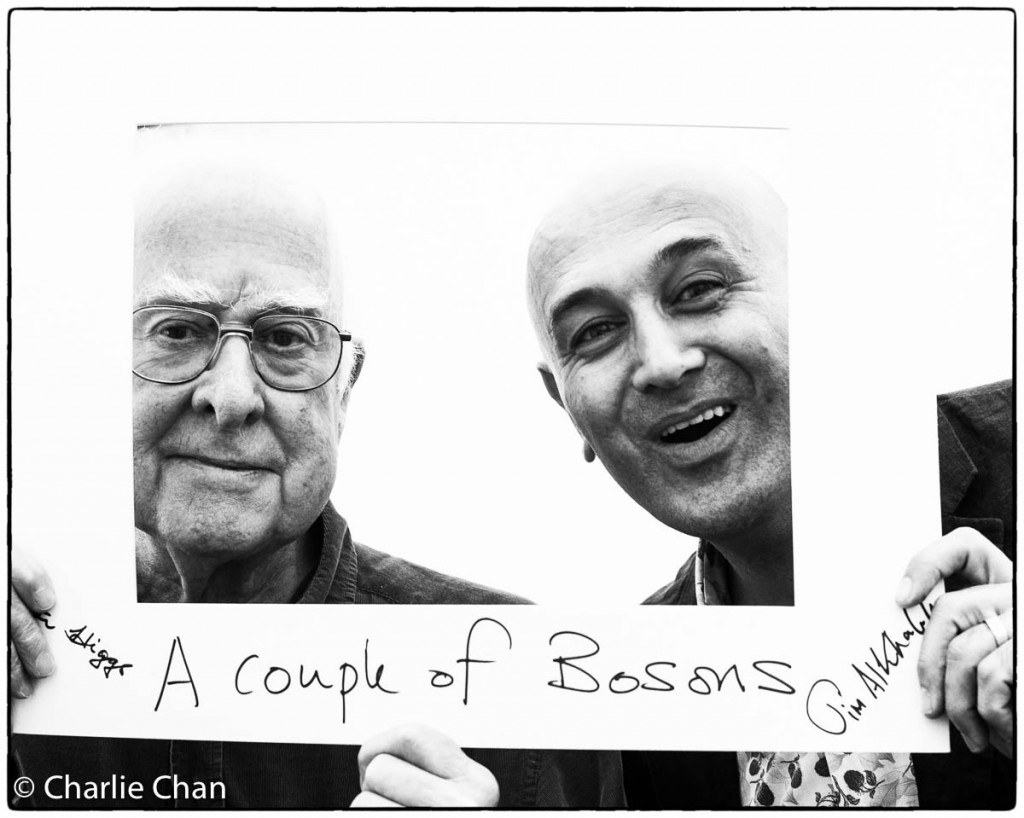Quantum physicist and broadcaster Jim Al-Khalili blogs on interviewing Peter Higgs for the new series of The Life Scientific on BBC Radio 4. Discover more about the LHC, particle physics and the search for the Higgs boson in our Collider exhibition.
I love name dropping about some of the science superstars I’ve interviewed on The Life Scientific. “Richard Dawkins was quite charming on the programme, you know”, or “James Lovelock is as sharp as ever”, and so on. So imagine my excitement when I heard I would be interviewing the ultimate science celebrity Peter Higgs.
When I discovered we had secured him for the first programme in the new 2014 series, I knew I had to get something more out of him than to simply regurgitate the popular account of the man as shy, modest and unassuming, and still awkward about having a fundamental particle named after him; or how the Nobel committee were unable to get hold of him on the day of the announcement because he had obliviously wandered off to have lunch with friends.
This was an opportunity for two theoretical physicists – OK, one who has a Nobel Prize to his name and one who doesn’t, but let’s not split hairs here – to chat about the thrill of discovery and to peek into the workings of nature, whilst the outside world listened in.

You can listen to the programme from 18 February, but here are a few extracts to whet your appetite.
Can you explain the Higgs mechanism in 30 seconds?
At some point in the programme, inevitably, I had to ask Peter to explain the Higgs mechanism and Higgs field (both more fundamental concepts than the Higgs boson). He gave a beautifully articulate and clear explanation, but I then thought I should ask him to give the ‘idiot’s guide to the Higgs’, just to cover all bases. Here’s how that went:
‘The Boson that Bears my Name’
Working alone in Edinburgh in the sixties, Peter Higgs was considered ‘a bit of a crank’. “No-one wanted to work with me”, he says. In 1964, he predicted the possible existence of a new kind of boson, but at the time there was little interest in this now much-celebrated insight. And in the years that followed, Peter Higgs himself failed to realise the full significance of his theory, which would later transform particle physics.
In July 2012, scientists at the Large Hadron Collider at CERN confirmed that the Higgs boson had indeed been found and Peter Higgs shot to fame. This ephemeral speck of elusive energy is now the subject of car adverts, countless jokes, museum exhibitions and even a song by Nick Cave called the Higgs Boson Blues. But Higgs has always called it the scalar boson or, jokingly, ‘the boson that bears my name’ and remains genuinely embarrassed that it is named after him alone.
In fact, three different research groups, working independently, published very similar papers in 1964 describing what’s now known as the Higgs mechanism. And Higgs told me he’s surprised that another British physicist, Tom Kibble from Imperial College, London didn’t share the 2013 Nobel Prize for Physics, along with him and Belgian physicist, Francois Englert.
On fame
When the 2013 Nobel Prize winners were announced, Peter was famously elusive (much to the frustration of the world’s media). Most people romanticised that he was blissfully unaware of all the fuss or just not that interested. These days, he’s constantly being stopped in the street and asked for autographs, so I asked him whether he enjoyed being famous:
Physics post-Higgs
With the discovery of the Higgs finally ticked off our to-do list, attention is turning to the next challenge: to find a new family of particles predicted by our current front-runner theory, called supersymmetry. Higgs would ‘like this theory to be right’ because it is the only way theorists have at the moment of incorporating the force of gravity into the grand scheme of things.
But what if the Large Hadron Collider doesn’t reveal any new particles? Will we have to build an even bigger machine that smashes subatomic particles together with ever-greater energy? In fact, Peter Higgs believes that the next big breakthrough may well come from a different direction altogether, for example by studying the behaviour of neutrinos, the elusive particles believed the be the most common in the Universe, which, as Higgs admits, “is not the sort of thing the Large Hadron Collider is good for”.
When it started up in 2008, physicists would not have dreamt of asking for anything bigger than the Large Hadron Colider. But today one hears serious talk of designing a machine that might one day succeed it. One candidate is the somewhat unimaginatively named Very Large Hadron Collider. Such a machine would dwarf the Large Hadron Collider. It would collide protons at seven times higher energy than the maximum the Large Hadron Collider is able to reach. And it would require a tunnel 100 km in circumference. Of course this is not the only proposal on the table and there are plenty of other ideas floating about – none of which come cheap, naturally.
There are certainly plenty more deep mysteries to solve, from the nature of dark matter and dark energy to where all the antimatter has gone, and we will undoubtedly find the answers (oh, the delicious arrogance of science). Let’s just hope we don’t have to wait as long as Peter Higgs did.
Keen to discover more? You can listen to Peter Higgs on BBC Radio 4’s The Life Scientific (first broadcast 9am on 18 February) and visit the Collider exhibition at the Science Museum until 5 May 2014.